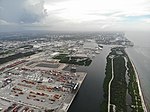The Art Institute of Fort Lauderdale

The Art Institute of Fort Lauderdale is a former for-profit art and culinary school in Fort Lauderdale, Florida which closed in 2018. The school was one of a number of Art Institutes, a franchise of for-profit art colleges with many branches in North America, owned and operated by Education Management Corporation. EDMC owned the college from 1973 until 2017, when, facing declining enrollment, multiple fraud charges brought by faculty and students, and accreditation issues at some of its schools, the company sold the Art Institute of Fort Lauderdale, along with other properties, to Dream Center Education, a Los Angeles-based Pentecostal organization. Dream Center Education planned to operate the school, along with others it acquired, as a non-profit. The plan proved unsustainable, with Dream Center permanently closing 18 Art Institute schools, including Art Institute of Fort Lauderdale, at the end of 2018.
Excerpt from the Wikipedia article The Art Institute of Fort Lauderdale (License: CC BY-SA 3.0, Authors, Images).The Art Institute of Fort Lauderdale
Marriott Drive, Fort Lauderdale
Geographical coordinates (GPS) Address Nearby Places Show on map
Geographical coordinates (GPS)
| Latitude | Longitude |
|---|---|
| N 26.1 ° | E -80.122 ° |
Address
Marriott Drive
Marriott Drive
33316 Fort Lauderdale
Florida, United States
Open on Google Maps







